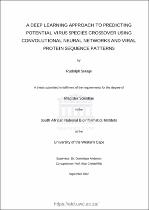| dc.description.abstract | Medical science has made substantial progress toward diagnosing, understanding the pathogenesis, and treating various causative agents of infectious disease; however, novel microbial pathogens continue to emerge, and existing pathogens continue to evolve alternative means to thrive in ever-changing environments. Various infectious disease etiological agents originate from animal reservoirs, and many have, over time, acquired the ability to cross the species barrier and alter their host range. The emergence and re-emergence of zoonotic pathogens is reported to be a consequence of changes in several factors, including ecological, behavioural, and socioeconomic variables which are arguably impossible to control. Computational methods with the capacity to evaluate large datasets, are considered invaluable tools for predicting and tracking disease outbreaks and are especially powerful when combined with machine learning techniques. | en_US |

